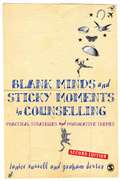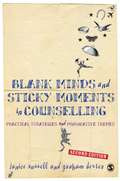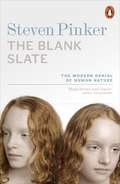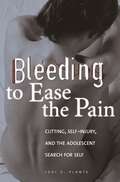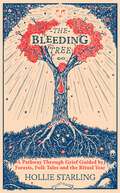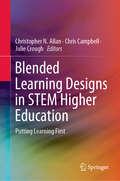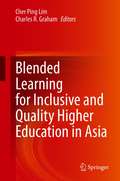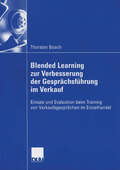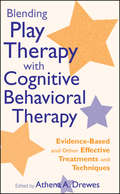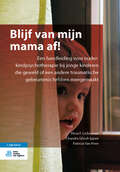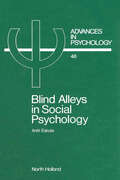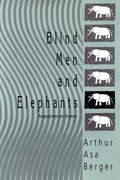- Table View
- List View
Blackwell Handbook of Social Psychology: Group Processes (Blackwell Handbooks of Social Psychology)
by Michael A. Hogg Scott TindaleThis handbook provides an authoritative, up-to-date overview of the social psychology of group processes. The topics covered include group decisions, juries, group remembering, roles, status, leadership, social identity and group membership, socialization, group performance, negotiation and bargaining, emotion and mood, computer-mediated communication, organizations and mental health. Provides an authoritative, up-to-date overview of the social psychology of group processes. Written by leading researchers from around the world to provide a classic and current overview of research as well as providing a description of future trends within the area. Includes coverage of group decisions, juries, group remembering, roles, status, leadership, social identity and group membership, socialization, group performance, negotiation and bargaining, emotion and mood, computer-mediated communication, organizations and mental health. Essential reading for any serious scholar of group behavior. Now available in full text online via xreferplus, the award-winning reference library on the web from xrefer. For more information, visit www.xreferplus.com
Blackwell Handbook of Social Psychology: Intraindividual Processes (Blackwell Handbooks of Social Psychology)
by Abraham Tesser Norbert SchwarzThis volume on intraindividual processes is one of a set of four handbooks in the social psychology field and covers social cognition, attitudes, and attribution theory. Includes contributions by academics and other experts from around the world to ensure a truly international perspective. Provides a comprehensive overview of classic and current research and likely future trends. Fully referenced chapters and bibliographies allow easy access to further study. Now available in full text online via xreferplus, the award-winning reference library on the web from xrefer. For more information, visit www.xreferplus.com
Blade Runner, Matrix und Avatare: Psychoanalytische Betrachtungen virtueller Wesen und Welten im Film
by Parfen LaszigIn dem Fachbuch analysieren renommierte Autoren rund 30 Filme unter psychodynamischen Gesichtspunkten: Wie weicht die Darstellung in den Medien von der Wirklichkeit ab? Und wie verändern sich Zuschauer, wenn sie damit konfrontiert sind? Am Beispiel bekannter und neu zu entdeckender Filme zeigen sie auf, wie sich virtuelle Realitäten, Konstrukte, Traumbilder und künstliche Wesen auf die Wahrnehmung des Zuschauers auswirken. Die Texte sind so geschrieben, dass sie auch für „psychoanalytische Laien“ verständlich und spannend zu lesen sind.
Blake's Job: Adventures in Becoming
by Jason WrightIn this unique book, Jason Wright analyses William Blake’s Illustrations of the Book of Job and shows their relevance in clinical psychoanalysis and psychotherapy with groups and individuals, especially while working with patients who have experienced trauma and addiction. Drawing on decades of work in the field, this book sees Wright offer sensitive guidance to practitioners dealing with client experiences of change through the lens of addiction and offers useful insight to the lay reader. Throughout the chapters, Wright studies each illustration in depth and shows how they chart the breakdown of Job’s life into a state of despair. Twinning a clinical vignette with each plate, Wright shows how these depictions can be directly applied to issues faced in contemporary analysis, therapy and addiction recovery. From Job’s dissolution to his eventual salvation, Wright insightfully maps the process of change from a place of destitution to one of redemption and hope set in the context of the group. He expertly brings Blakean theory into the 21st century by looking at contemporary experience such as the impact of the 2005 London bombings, as well as looking at the importance of community, collective experience and self-identity when seeking recovery. Throughout, Wright draws inspiration from eminent analysts such as Bion, Winnicott and Hillman, while also looking to Jung, Bohm and Whitehead to support his theories on the new way of being he proposes: a collective dynamic shift from a consciousness of exploitation to a consciousness of resonance. This book will be of great interest to psychoanalysts, psychotherapists and mental health professionals working in addiction recovery, as well as those interested in the work of Blake and its continued importance in the present day.
Blake's Job: Adventures in Becoming
by Jason WrightIn this unique book, Jason Wright analyses William Blake’s Illustrations of the Book of Job and shows their relevance in clinical psychoanalysis and psychotherapy with groups and individuals, especially while working with patients who have experienced trauma and addiction. Drawing on decades of work in the field, this book sees Wright offer sensitive guidance to practitioners dealing with client experiences of change through the lens of addiction and offers useful insight to the lay reader. Throughout the chapters, Wright studies each illustration in depth and shows how they chart the breakdown of Job’s life into a state of despair. Twinning a clinical vignette with each plate, Wright shows how these depictions can be directly applied to issues faced in contemporary analysis, therapy and addiction recovery. From Job’s dissolution to his eventual salvation, Wright insightfully maps the process of change from a place of destitution to one of redemption and hope set in the context of the group. He expertly brings Blakean theory into the 21st century by looking at contemporary experience such as the impact of the 2005 London bombings, as well as looking at the importance of community, collective experience and self-identity when seeking recovery. Throughout, Wright draws inspiration from eminent analysts such as Bion, Winnicott and Hillman, while also looking to Jung, Bohm and Whitehead to support his theories on the new way of being he proposes: a collective dynamic shift from a consciousness of exploitation to a consciousness of resonance. This book will be of great interest to psychoanalysts, psychotherapists and mental health professionals working in addiction recovery, as well as those interested in the work of Blake and its continued importance in the present day.
Blame and Political Attitudes: The Psychology of America's Culture War
by Gail SaharQuestions about the causes of events, from terrorist attacks to mass shootings to economic and public health crises dominate conversations across the US. Recent research in social psychology outlines the process we use to identify the causes of such events, reveals how we determine who is responsible or to blame, and documents the far-reaching consequences of these determinations for our emotions, our actions, and our attitudes.Current approaches to political opinions posit a direct path from a person’s worldview (liberal or conservative) to their attitudes toward specific political issues like abortion and welfare. This book argues that blame is the missing link between the two. Gail Sahar demonstrates that the current emphasis on value differences, whether between conservatives and liberals in the U.S. or between religious and secular countries on a global level, ignores commonalities in the way people think about issues. She proposes that focusing on perceived causes of social problems is a much more promising avenue for dialog than trying to reconcile fundamental belief systems. Informed by the latest psychological science, this new take on how to change attitudes has implications for anyone seeking to influence the viewpoints of others, from politicians and activists to ordinary people talking about current events at a dinner party.
Blank Minds and Sticky Moments in Counselling: Practical Strategies and Provocative Themes
by Graham Dexter Dr Janice Dexter'I recommend the book as an essential, core, alternative or complementary text for trainees in counselling, hitting as it does, just the right notes of honesty, realism, humour and theory-made-digestible. It deserves to be on the reading lists of all certificate and diploma courses - now' - Colin Feltham, Sheffield Hallam University Blank Minds and Sticky Moments in Counselling, Second Edition is a popular and down-to-earth guide to the common challenges which arise in everyday counselling practice. Drawing on humour and over 30 years experience, the authors describe a range of strategies to help practitioners and trainees through the 'sticky' moments and offer reassurance that 'you are not alone' in facing these dilemmas. The book explores what to do when you: " feel stuck and are failing to help the client move forward " are faced with a client who struggles with verbal communication " encounter a client with mental-health problems " find interpersonal issues are affecting your view of a client " find yourself at odds with the values of your client The authors also tackle broader issues concerning what it means to be professional, tensions between theory and practice and offer a four-stage model of counselling as a framework for practice. The underlying goal of the book is to help readers see difficult moments as learning experiences and to feel empowered to be imaginative, creative and flexible practitioners. Blank Minds and Sticky Moments in Counselling, Second Edition is a rich source of practical advice for trainees and practitioners. Graham Dexter and Janice Russell are freelance trainers and consultants in counselling.
Blank Minds and Sticky Moments in Counselling (2nd edition) (PDF)
by Russell Janice Dexter GrahamBlank Minds and Sticky Moments in Counselling, Second Edition is a popular and down-to-earth guide to the common challenges which arise in everyday counselling practice. Drawing on humour and over 30 years experience, the authors describe a range of strategies to help practitioners and trainees through the 'sticky' moments and offer reassurance that 'you are not alone' in facing these dilemmas. The authors also tackle broader issues concerning what it means to be professional, tensions between theory and practice and offer a four-stage model of counselling as a framework for practice. The underlying goal of the book is to help readers see difficult moments as learning experiences and to feel empowered to be imaginative, creative and flexible practitioners. Blank Minds and Sticky Moments in Counselling, Second Edition is a rich source of practical advice for trainees and practitioners. Graham Dexter and Janice Russell are freelance trainers and consultants in counselling.
The Blank Slate: The Modern Denial of Human Nature (Penguin Press Science Ser.)
by Steven Pinker"In a work of outstanding clarity and sheer brilliance Steven Pinker banishes forever fears that a biological understanding of human nature threatens humane values" - Helena Cronin, author of THE ANT and THE PEACOCK."A mind blowing, mind openingexposé. Pinker's profoundly positive arguments for the compatibility of biology and humanism are unrivalled for their scope and depth and should be mandatory, if disquieting, reading"Patricia Goldman-Rakic - Past President of the Society for Neuroscience.
Bleeding to Ease the Pain: Cutting, Self-Injury, and the Adolescent Search for Self (Abnormal Psychology)
by Lori G. PlanteParents, teachers, friends, and even many clinicians are both horrified and mystified upon discovering teenagers who intentionally cut, burn, and otherwise inflict pain upon themselves. Often causing permanent and extensive scarring, as well as infections, cutting is increasingly prevalent among today's youth. As many as 1 in 100 adolescents report cutting themselves, representing a growing epidemic of scarred and tormented youths, as we see in this revealing work. As author Plante discusses here, the threat of suicide must always be carefully evaluated, although the majority of cutters are not in fact suicidal. Instead, cutting represents a growing teenage method for easing emotional pain and suffering. Bleeding from self-inflicted wounds not only helps to numb and vent the despair, it can also be a dramatic means of communicating, controlling, and asking for help from others.Parents, teachers, friends, and even many clinicians are both horrified and mystified upon discovering teenagers who intentionally cut, burn, and otherwise inflict pain on themselves. Often causing permanent and extensive scarring, as well as infections, cutting is increasingly prevalent among today's youth. As many as 1 in 100 adolescents report cutting themselves, representing a growing epidemic of scarred and tormented youth, as we see in this revealing work. Author Plante explains the threat of suicide must always be carefully evaluated, although the vast majority of cutters are not in fact suicidal. Instead, cutting represents a growing teenage method for easing emotional pain and suffering. Bleeding from self-inflicted wounds not only helps to numb and vent despair, it can also be a dramatic means of communicating, controlling, and asking for help from others.In this book, Plante features the stories of self-injurers and helps the reader understand the meaning of the injuries, and how to help teens stop. This author, who is a psychologist, a parent, and a Stanford University Medical School faculty member, explains in clear detail how cutters and the adults who love them can heal the pain and stop self-injury. Plante describes the frightening developmental tasks teenagers and young adults face, and how the central challenges of the three I's (Independence, Intimacy, and Identity) compel them to cope through self-destructive acts. Readers will feel as if they are in the therapy room with Plante and these struggling teenagers as they seek to overcome their internal pain and that desperate need to cut and self-injure.
The Bleeding Tree: A Pathway Through Grief Guided by Forests, Folk Tales and the Ritual Year
by Hollie StarlingIt was the last of the ebbing days, the brink of the new season. It was the murky hours, the clove between sunset and sunrise. It was a tall tree with deep roots and it had been bleeding for a long while.As summer falls into autumn, Hollie Starling is hit by the heart-stopping news that her father has died by suicide. Thrust into a state of 'grief on hard mode', Hollie feels underserved by current attitudes toward grief and so seeks another way through the dark.Following her first year without her father, Hollie embraces her lifelong interest in folklore and turns to the healing power of nature, the changing seasons and the rituals of ancient communities. The Bleeding Tree is an unflinching year-zero guidebook to grief that shows us that by looking back to past traditions of bereavement we can all find our own way forward.
Blended Learning Designs in STEM Higher Education: Putting Learning First
by Christopher N. Allan Chris Campbell Julie CroughThis book offers a set of learning principles to support the design of rich learning experiences in Science, Technology, Engineering and Mathematics (STEM) higher education, including detailed evaluations and discussions for a variety of science subjects. Further, it presents a professional learning framework that can be used to support the implementation of blended learning technologies to increase buy-in from academic staff, to support grass roots initiatives, to develop a sense of community, and to sustain change. The principles developed here will help readers to think about blended learning from a learner’s perspective, put learning first, and develop activities that will help learners achieve better learning outcomes.In addition, the book addresses how to design rich, evidence-based, blended learning experiences that support learning. It demonstrates a range of learning principles in practice, with step-by-step instructions, and includes templates, supporting material, instructions and other resources to help teachers embed and adapt designs in their own subject. Readers will be equipped with an expanded toolkit of resources, designs, ideas and activities that can be directly applied in a variety of subject areas.
Blended Learning for Inclusive and Quality Higher Education in Asia
by Charles R. Graham Cher Ping LimThis book demonstrates how blended learning improves access to and enhances the quality of higher education teaching and learning in Asian universities. It first discusses how leading universities in the region drive and support blended learning at the institutional level to enhance student learning engagement and outcomes. It then examines 10 effective implementations and lessons learned of blended learning practices across different disciplinary courses and programmes (humanities and language, science and engineering, social science and education, and others) in the region. The chapters in this book provide an overview of the opportunities and challenges of blended learning for improved access and enhanced quality of higher education, and offer insights into the promising blended learning policies and practices in Asian universities.
Blended Learning für die Unternehmensdigitalisierung: Qualifizieren Sie Führungskräfte zu Botschaftern des digitalen Wandels (essentials)
by Winfried Krieger Stephan HofmannDieses essential zeigt, wie Sie in der neuen digitalen Welt Lernen und Qualifizieren gestalten können, damit sich Kommunikation und Führung verändern und Führungskräfte zu digitalen Botschaftern in ihrem eigenen Unternehmen werden. Nichts ist so praktisch wie eine gute Theorie – deshalb erläutern die Autoren die Konzepte des 70-20-10-Referenzmodells sowie die motivationalen Ideen der Self-Determination-Theory und der systemisch-konstruktivistischen Didaktik. Auf dieser Grundlage wird ein erprobtes Kurs- und Lerndesign vorgestellt, das sich am Konzept des erweiterten Blended Learning orientiert und nachhaltige Umsetzungserfolge ermöglicht.
Blended Learning zur Verbesserung der Gesprächsführung im Verkauf: Einsatz und Evaluation beim Training von Verkaufsgesprächen im Einzelhandel
by Thorsten BoschThorsten Bosch stellt die Messbarkeit des Trainingserfolgs im soft-skill-Bereich in den Mittelpunkt seiner Untersuchung und evaluiert das von ihm selbst entwickelte "Bosch-Modell", ein Blended Learning-Konzept zur Verbesserung der Fähigkeit zum Führen von Verkaufsgesprächen. Hierbei stützt er sich auf laufende Kundenprojekte seines Beratungsunternehmens und misst sozusagen in Echtzeit.
Blending Play Therapy with Cognitive Behavioral Therapy: Evidence-Based and Other Effective Treatments and Techniques
by Athena A. DrewesIn today's managed-care environment, therapeutic techniques must be proven to be effective to be reimbursable. This comprehensive volume is written by leaders in the field and collects classic and emerging evidence-based and cognitive behavioral therapy treatments therapists can use when working with children and adolescents. Step-by-step instruction is provided for implementing the treatment protocol covered. In addition, a special section is included on therapist self-care, including empirically supported studies. For child and play therapists, as well school psychologists and school social workers.
Blending Play Therapy with Cognitive Behavioral Therapy: Evidence-Based and Other Effective Treatments and Techniques
by Athena A. DrewesIn today's managed-care environment, therapeutic techniques must be proven to be effective to be reimbursable. This comprehensive volume is written by leaders in the field and collects classic and emerging evidence-based and cognitive behavioral therapy treatments therapists can use when working with children and adolescents. Step-by-step instruction is provided for implementing the treatment protocol covered. In addition, a special section is included on therapist self-care, including empirically supported studies. For child and play therapists, as well school psychologists and school social workers.
Blijf van mijn mama af!: Een handleiding voor ouder-kindpsychotherapie bij jonge kinderen die geweld of een andere traumatische gebeurtenis hebben meegemaakt
by Alicia F. Lieberman Chandra Ghosh Ippen Patricia Van HornDit boek is een handleiding voor ouder-kindpsychotherapie (CPP, child-parent psychotherapy). Het richt zich op therapeuten die jonge tot zeer jonge kinderen (0 tot 5 jaar) behandelen die geweld of een andere traumatische gebeurtenis hebben meegemaakt. Het boek geeft theoretische achtergronden vanuit de psychoanalyse, de hechtingstheorie en de ontwikkelingspathologie. Ook geeft het voorbeelden van toe te passen interventies. Blijf van mijn mama af! laat zien dat ouder-kindpsychotherapie een waardevolle behandelvorm is voor jonge kinderen die getuige of slachtoffer zijn (geweest) van huiselijk geweld. De therapie kan ook worden toegepast bij andere vormen van trauma zoals emotionele, lichamelijke en seksuele mishandeling, blootstelling aan geweld, ernstige verwondingen, pijnlijke ziektes en medische behandelingen. De beschreven therapie is evidencebased en nadrukkelijk gericht op de relatie met de ouders of verzorgers van het kind. Hierbij is veel aandacht voor veiligheid en vertrouwen tegenover gevaar en angst. Van alle interventies worden voorbeelden gegeven aan de hand van vijf uitgebreide casussen en in de vorm van vele kortere vignetten. Deze, uit het Engels vertaalde, uitgave is een tweede, herziene druk van Don’t hit my mommy!, oorspronkelijk uitgegeven door ZERO TO THREE: National Center for Infants, Toddlers and Families in 2015. ‘Dit klassieke werk is gebaseerd op tientallen jaren ervaring van de auteurs als therapeut en opleider. De toepassing van ouder-kindpsychotherapie (CPP) is sinds verschijning van het oorspronkelijke boek aanzienlijk uitgebreid, met name voor gezinnen die te maken hebben met geweld, op basis van een indrukwekkende hoeveelheid wetenschappelijk bewijs en steeds meer trainers. Naast een rijke hoeveelheid andere hulpmiddelen biedt het boek vele gedetailleerde, fijngevoelige en helder geschreven voorbeeldcasussen die laten zien hoe je ouders en jonge kinderen kunt bijstaan bij het genezen van trauma’s. Ik raad u aan het te lezen, en te herlezen.’ – Charles H. Zeanah jr., MD, Institute of Infant and Early Childhood Mental Health, Tulane University
Blind Alleys in Social Psychology: A Search for Ways Out (ISSN #Volume 48)
by A. Eskola A. Kihlström D. Kivinen K. Weckroth O.-H. YlijokiReal advances are not made in blind alleys (or culs-de-sac). In Social Psychology, as in every branch of science, the paths which appear to offer progress do not always result in theoretical elegance. Certain basic problems persistently defy final solution.This volume surveys the foundations and methods of Social Psychology with the aim of identifying ways out of the research maze. It examines the history and traditions of the field, looks at methodology and conceptual schemes, and discusses the actual research methods used.
The Blind Man Sees: Freud's Awakening and Other Essays
by Neville SymingtonThe papers in this book have been written over a period of fifteen years, and focus in the similarity between psychoanalysis and religion. The author argues that psychoanalysis can be seen as a scientific religion with Freud as the leader of the movement. He examines the various stages of the journey made by a religious leader from "blindness" to "founding an institution" and finds counterparts in the development of psychoanalysis while drawing examples from Buddhism, Christianity and Islam. He invites the reader on a journey with him - to examine the human mind, our society, the process of psychoanalysis, science and philosophy. He successfully uses examples from the consulting room to illuminate his arguments. The author's honest accounts of the search for answers relevant to all of us encourage the reader to think further and deeper than he or she had intended. 'The psychoanalyst examines scientifically the emotional pattern in himself and the other.
The Blind Man Sees: Freud's Awakening and Other Essays
by Neville SymingtonThe papers in this book have been written over a period of fifteen years, and focus in the similarity between psychoanalysis and religion. The author argues that psychoanalysis can be seen as a scientific religion with Freud as the leader of the movement. He examines the various stages of the journey made by a religious leader from "blindness" to "founding an institution" and finds counterparts in the development of psychoanalysis while drawing examples from Buddhism, Christianity and Islam. He invites the reader on a journey with him - to examine the human mind, our society, the process of psychoanalysis, science and philosophy. He successfully uses examples from the consulting room to illuminate his arguments. The author's honest accounts of the search for answers relevant to all of us encourage the reader to think further and deeper than he or she had intended. 'The psychoanalyst examines scientifically the emotional pattern in himself and the other.
Blind Men and Elephants: Perspectives on Humor
by Arthur Asa BergerIn Blind Men and Elephants, Arthur Asa Berger uses case histories to show how scholars from different disciplines and scholarly domains have tried to describe and understand humor. He reveals not only the many approaches that are available to study humor, but also the many perspectives toward humor that characterize each discipline. Each case history sheds light on a particular aspect of humor, making the combination of approaches of considerable value in the study of social research.Among the various disciplines that Berger discusses in relation to humor are: communication theory, philosophy, semiotics, literary analysis, sociology, political science, and psychology. Berger deals with these particular disciplines and perspectives because they tend to be most commonly found in the scholarly literature about humor as well as being those that have the most to offer. Blind Men and Elephants covers a wide range of humor, from simple jokes to the uses of literary devices in films. Berger observes how humor often employs considerable ridicule directed at diverse groups of people: women, men, animals, politicians, African Americans, Jews, Catholics, Protestants, gay people, straight people, and so forth. The book also explains the risk factor in ridicule as a humorous device.Blind Men and Elephants depicts how one entity or one situation can be viewed in as many different ways as the number of people studying it. Berger also shows how those multiple perspectives, the Rashomon Effect, can be used together to create a clearer understanding of humor. Blind Men and Elephants is a valuable companion to Berger's recent effort about humor, An Anatomy of Humor, and will be enjoyed by communication and information studies scholars, sociologists, literary studies specialists, philosophers, and psychologists.
Blind Men and Elephants: Perspectives on Humor
by Arthur Asa BergerIn Blind Men and Elephants, Arthur Asa Berger uses case histories to show how scholars from different disciplines and scholarly domains have tried to describe and understand humor. He reveals not only the many approaches that are available to study humor, but also the many perspectives toward humor that characterize each discipline. Each case history sheds light on a particular aspect of humor, making the combination of approaches of considerable value in the study of social research.Among the various disciplines that Berger discusses in relation to humor are: communication theory, philosophy, semiotics, literary analysis, sociology, political science, and psychology. Berger deals with these particular disciplines and perspectives because they tend to be most commonly found in the scholarly literature about humor as well as being those that have the most to offer. Blind Men and Elephants covers a wide range of humor, from simple jokes to the uses of literary devices in films. Berger observes how humor often employs considerable ridicule directed at diverse groups of people: women, men, animals, politicians, African Americans, Jews, Catholics, Protestants, gay people, straight people, and so forth. The book also explains the risk factor in ridicule as a humorous device.Blind Men and Elephants depicts how one entity or one situation can be viewed in as many different ways as the number of people studying it. Berger also shows how those multiple perspectives, the Rashomon Effect, can be used together to create a clearer understanding of humor. Blind Men and Elephants is a valuable companion to Berger's recent effort about humor, An Anatomy of Humor, and will be enjoyed by communication and information studies scholars, sociologists, literary studies specialists, philosophers, and psychologists.
Blind Spots: Why We Fail to Do What's Right and What to Do about It
by Max H. Bazerman Ann E. TenbrunselWhen confronted with an ethical dilemma, most of us like to think we would stand up for our principles. But we are not as ethical as we think we are. In Blind Spots, leading business ethicists Max Bazerman and Ann Tenbrunsel examine the ways we overestimate our ability to do what is right and how we act unethically without meaning to. From the collapse of Enron and corruption in the tobacco industry, to sales of the defective Ford Pinto, the downfall of Bernard Madoff, and the Challenger space shuttle disaster, the authors investigate the nature of ethical failures in the business world and beyond, and illustrate how we can become more ethical, bridging the gap between who we are and who we want to be. Explaining why traditional approaches to ethics don't work, the book considers how blind spots like ethical fading--the removal of ethics from the decision--making process--have led to tragedies and scandals such as the Challenger space shuttle disaster, steroid use in Major League Baseball, the crash in the financial markets, and the energy crisis. The authors demonstrate how ethical standards shift, how we neglect to notice and act on the unethical behavior of others, and how compliance initiatives can actually promote unethical behavior. They argue that scandals will continue to emerge unless such approaches take into account the psychology of individuals faced with ethical dilemmas. Distinguishing our "should self" (the person who knows what is correct) from our "want self" (the person who ends up making decisions), the authors point out ethical sinkholes that create questionable actions. Suggesting innovative individual and group tactics for improving human judgment, Blind Spots shows us how to secure a place for ethics in our workplaces, institutions, and daily lives.
Blind Spots: Why We Fail to Do What's Right and What to Do about It (PDF)
by Max H. Bazerman Ann E. TenbrunselWhen confronted with an ethical dilemma, most of us like to think we would stand up for our principles. But we are not as ethical as we think we are. In Blind Spots, leading business ethicists Max Bazerman and Ann Tenbrunsel examine the ways we overestimate our ability to do what is right and how we act unethically without meaning to. From the collapse of Enron and corruption in the tobacco industry, to sales of the defective Ford Pinto, the downfall of Bernard Madoff, and the Challenger space shuttle disaster, the authors investigate the nature of ethical failures in the business world and beyond, and illustrate how we can become more ethical, bridging the gap between who we are and who we want to be. Explaining why traditional approaches to ethics don't work, the book considers how blind spots like ethical fading--the removal of ethics from the decision--making process--have led to tragedies and scandals such as the Challenger space shuttle disaster, steroid use in Major League Baseball, the crash in the financial markets, and the energy crisis. The authors demonstrate how ethical standards shift, how we neglect to notice and act on the unethical behavior of others, and how compliance initiatives can actually promote unethical behavior. They argue that scandals will continue to emerge unless such approaches take into account the psychology of individuals faced with ethical dilemmas. Distinguishing our "should self" (the person who knows what is correct) from our "want self" (the person who ends up making decisions), the authors point out ethical sinkholes that create questionable actions. Suggesting innovative individual and group tactics for improving human judgment, Blind Spots shows us how to secure a place for ethics in our workplaces, institutions, and daily lives.





